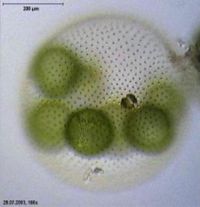Volvox carteri
Overview

Volvox is one of the best-known chlorophytes and is the most developed in a series of genera that form spherical colonies. Each Volvox is composed of numerous flagellate cells similar to Chlamydomonas, on the order of 10003000 in total, interconnected and arranged in a glycoprotein-filled sphere (coenobium). The cells swim in a coordinated fashion, with a distinct anterior and posterior or since Volvox resembles a little planet, a 'north' pole and a 'south' pole. The cells have eyespots, more developed near the anterior, which enable the colony to swim towards light.
An asexual colony includes both somatic, or vegetative, cells, which do not reproduce, and gonidia near the posterior, which produces new colonies through repeated division. These daughter colonies are initially held within the parent and have their flagella directed inwards. Later, the parent disintegrates and the daughters invert. In sexual reproduction two types of gametes are produced. Volvox species can be monoecious or dioecious. Male colonies release numerous microgametes, or sperm, while in female colonies single cells enlarge to become oogametes, or eggs.
Further reading:
Genomic analysis of organismal complexity in the multicellular green alga Volvox carteri Science 329(5988), 223-6 (2010). [pubmed]
- Source
- JGI 1.0
- PLAZA identifier
- vca
- NCBI link
- Volvox carteri
- Mitochondrion
- Not available
- Chloroplast
- Not available
Toolbox
Various
- PLAZA download section
- Explore functional clusters
- Documentation data content
- View organism in the Genomeview or in the AnnoJ genome browser.
- View Volvox carteri specific or enriched gene families

Loading...please wait

Loading...please wait

Loading...please wait












